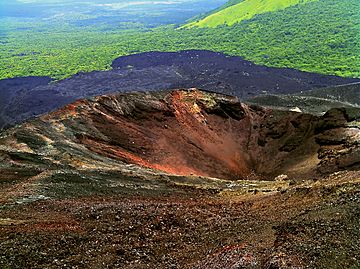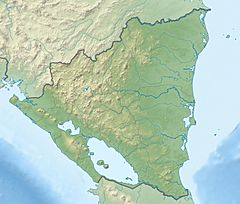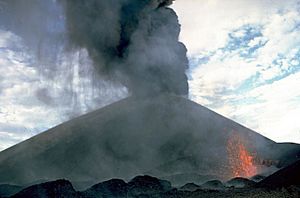Cerro Negro facts for kids
Quick facts for kids Cerro Negro |
|
|---|---|

Cerro Negro on August 20, 2011
|
|
| Highest point | |
| Elevation | 728 m (2,388 ft) |
| Geography | |
| Location | León Department, Nicaragua |
| Parent range | Cordillera de los Maribios |
| Geology | |
| Mountain type | Cinder cones |
| Last eruption | August 1999 |
Cerro Negro is a very active volcano in Nicaragua. It's part of the Cordillera de los Maribios mountain range. The volcano is about 10 kilometers (6 miles) from the village of Malpaisillo.
Cerro Negro is the youngest volcano in Central America. It first appeared in April 1850. Its name means "Black Hill" because it's made of dark, gravelly rock. This makes it stand out from the green hills around it.
This volcano is a type called a cinder cone. It has erupted many times since it was born. Sometimes, ash comes out of the top, while lava flows from cracks at the bottom. Cerro Negro is part of the Central America Volcanic Arc. This arc formed because the Cocos Plate is sliding under the Caribbean Plate.
Even though it's young, Cerro Negro is one of Nicaragua's busiest volcanoes. It has erupted about 23 times since 1850. Its last eruption was in 1999.
Contents
Cerro Negro's Eruptions
Cerro Negro has a long history of eruptions. Scientists use something called the Volcanic Explosivity Index (VEI) to measure how powerful an eruption is. It goes from 0 (small) to 8 (huge).
First Eruption in 1850
The first eruption of Cerro Negro happened on April 13, 1850. It lasted until May 27. Lava flowed, and there was damage to land. This eruption was a VEI 2, which is a moderate explosion.
Big Eruptions Through the Years
Cerro Negro erupted again in 1867 and 1899. These were also VEI 2 eruptions. In 1914, mudslides happened, but no one was hurt.
The volcano had its largest eruption on October 23, 1923. This was a VEI 3 eruption. It was much more powerful, with a lot of lava and ash.
In 1947, Cerro Negro had another big eruption. It was a VEI 3 and caused people in Malpaisillo to evacuate. There was a lot of damage to homes and land. Smaller eruptions followed in 1948, 1949, and 1950.
More eruptions happened in the 1950s and 1960s. These included lava flows and ash falls.
1968 Eruption and New Crater
From October to December 1968, Cerro Negro erupted again. This VEI 3 eruption was important because it created a new crater called Cristo Rey. Ash fell heavily, even in the city of León, which is 2nd largest city in Nicaragua. Lava flowed from three craters, shooting up to 30 meters (100 feet) high. Ash clouds reached up to 4.8 kilometers (3 miles) into the sky.
1971 Eruption and Ash Damage
In 1971, another strong VEI 3 eruption happened. Towns nearby had to be evacuated. Volcanic bombs (hot rocks) were thrown 600 meters (nearly 2,000 feet) into the air. Ash columns reached 10 kilometers (6 miles) high. This eruption caused a lot of ash to fall, damaging crops and buildings. León received 18 centimeters (7 inches) of ash, causing many roofs to collapse.
1992 Eruption and Evacuations
After more than 20 years of quiet, Cerro Negro erupted again on April 9, 1992. This was one of its biggest eruptions. It was a VEI 3 and lasted five days. The ash column reached about seven kilometers (4 miles) high. Over 20,000 people had to leave their homes. This eruption caused some deaths and a lot of damage. Ash covered León, leading to collapsed roofs.
1995 Eruption and Growth
In 1995, Cerro Negro had a two-part eruption. First, there were many small explosions each day. Then, bigger eruptions started, throwing out large rocks. Lava flowed, filling part of the 1992 crater. It also flowed 1.5 kilometers (about a mile) north. Ash fell on farms and homes. About 6,000 people were safely evacuated. This eruption added about 50 meters (164 feet) to the volcano's height.
1999 Eruption and Earthquakes
The most recent eruption of Cerro Negro was on August 5, 1999. It lasted two days. This time, three strong earthquakes happened just before the eruption. This was the first time earthquakes were known to trigger an eruption at Cerro Negro. It was a smaller VEI 1 eruption. New vents formed on the south side of the volcano.
After the 1999 eruption, the volcano's crater and cracks still release a lot of volcanic gas. Scientists have studied Cerro Negro's eruptions. They found that the size of past eruptions can help predict future ones.
Volcano Hazards
Like most volcanoes, Cerro Negro can be dangerous. Its hazards include:
- Lava flows
- Mudslides
- Pyroclastic flows (fast-moving hot gas and ash)
- Earthquakes
The biggest danger from Cerro Negro is the ash and tephra (rock fragments) that fall.
Monitoring Cerro Negro
Cerro Negro is watched closely by the Nicaraguan Seismic Network. This group has monitoring stations on the volcano. They check for:
- Seismic activity (earthquakes)
- Gas levels
- Changes in the ground's shape
- Temperature changes
Because Cerro Negro is in a less crowded area, fewer people are at risk. Mudslides and pyroclastic flows usually don't reach big cities. However, the ash falls can still cause major damage to buildings and farms.
See also
 In Spanish: Cerro Negro (volcán) para niños
In Spanish: Cerro Negro (volcán) para niños
- List of volcanoes in Nicaragua
Images for kids







